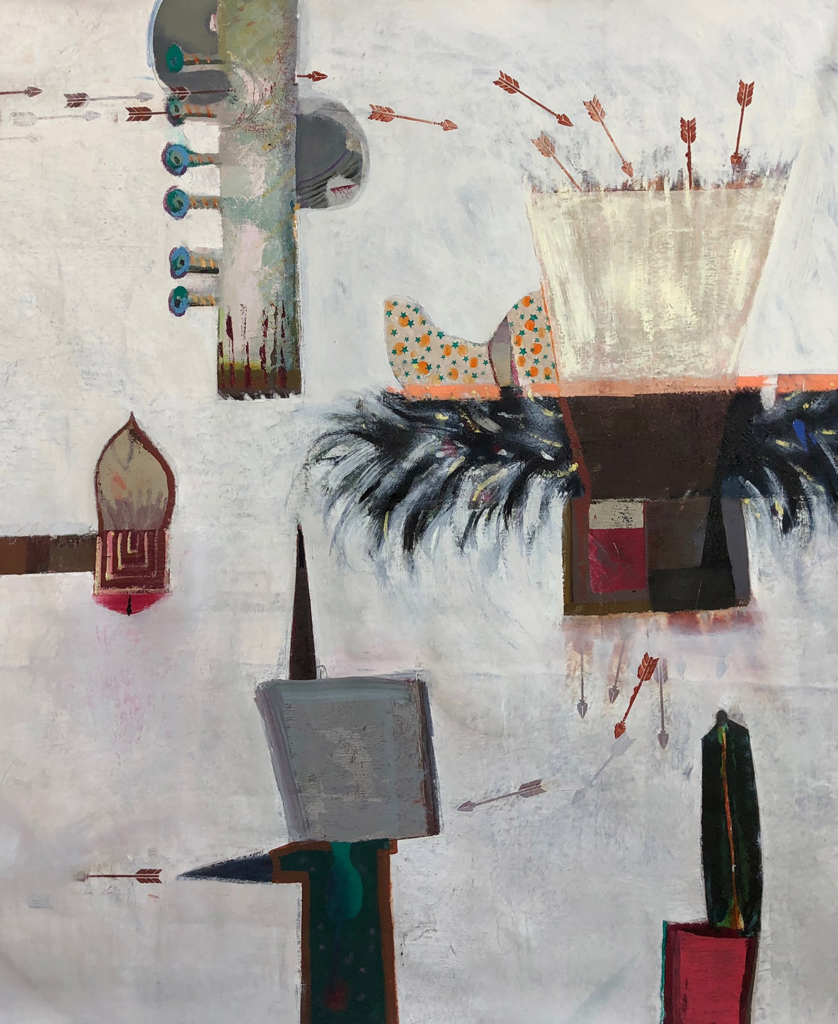
Statement
The mind can conjure up images that we have not actually witnessed or experienced, but these mental pictures still partake of the substance and sensory information of the physical world. In his artwork, Corliss Cavalieri doesn’t so much depict but offers suggestive visual prompts the very ambiguity of which implies there’s something there. Simplified though his forms may be, they possess descriptive detail and portray kinetic situations that belie the artist’s complex multilevel process and a sophisticated blending of historic and global art traditions.
Using the materiality of his media and language of representation, Cavalieri lends identifiable qualities and the sense of animation to the elements of his composition. We recognize something as tall, slender, prickly, fuzzy, bulbous, etc., and we read actions of tumbling, piercing, twisting, vaporizing, and so on. These are fanciful constructs in which nouns are ciphers between adjectives and verbs. Relying on our internalized sense of gravity, Cavalieri creates landscapes in which the liquid nature of paint viscerally registers the up-and-down of spatial logic, slyly lending mass and weight or their opposite to his sensual, absurd fabrications.
While he can populate his canvases with a baroque raucousness of color and curiosities, other paintings in Imagine That are characterized by his recent inclination to pull back. This speaks to Cavalieri’s increased interest in an ongoing practice of sketching and calling upon what emerges in drawing for his work in oils. With materials readily at hand, drawing is an intimate, potentially immediate activity, especially if an artist incorporates it into their daily routine as a place for experimentation. Releasing Impulse into mark makes for line and shade to take their own course, with objects, effects, patterns, and motifs taking shape. Having a kind of tactile intelligence, Cavalieri feels his media on the paper surface and anticipates the transposition from dry to wet and what can happen in the negative spaces of an oil painting. The drawing becomes both a scaffolding and an underpainting, as he adds and works layers of paint that submerge or eliminate. Some forms survive on the surface, and the field between becomes “activated with these misty pentimenti passages.”
Cavalieri partners with the materiality of paint. He celebrates their fluidity and drippiness, such that there are gestures and directional signals that read as descending. He can work with this or against this in his imagery, as in the case of strokes registering as some sort of downfall or conversely of balloon shapes ascending. Dimension is not a matter of rendering but of strata. Loving to scrape into his pigments, the surface is at once emphasized and a portal to the depths beneath. What initially appears to be simply ground between figures is filled with the traces of Cavalieri’s activity, and the seemingly elementary gives way to enhancement born of the artist’s process. As with our internal picturing, the vivid becomes elusive, and we seek with our mind’s eye to call up our thoughts, memories, and dreams.
There is a liminality to Cavalieri’s art akin to the disorientation in the middle of a rite of passage: the old order dissolved, participants are suspended in a malleable state between what was and what will be. In this regard, even though his paintings and drawings have figures, they are anti-narrative in that there are no outcomes. Cavalieri can be smitten by the flash of an electric green sleeve in a Veronese painting that spawns a series of drawings or paintings. He deals in such isolated and decontextualized details taken from art and life that are not about story or symbolism but the experience of the ineffable. In his comical way, Cavalieri makes an art that is about the unspoken — a presence felt by its effect but remaining an enigmatic “that.”